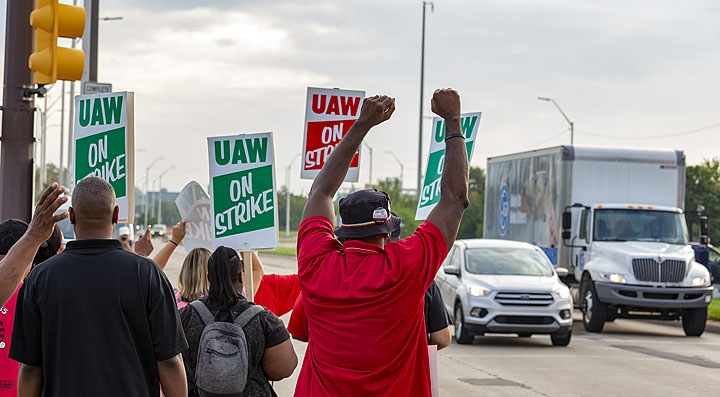GM Strikers Have More than "One Tool"
In a post to this blog on September 18, “GM Strikers Say ‘No More Tiers, ‘” Slaughter and Brooks say, “GM strikers have just one tool to use between their rock and their hard place: their right to vote no.”
However, rejecting a contract is not enough to get the GM strikers out between their rock and their hard place. And it isn’t the only tool they can use, either.
First, it isn’t enough. Slaughter and Brooks themselves show why. They give the example of 2015 Chrysler workers organized and rejected their TA. Slaughter and Brooks themselves say, “the offer was improved, establishing a ‘grow-in for second-tier workers to full pay, (though still without pensions or the same health care plan.)” They don’t mention how long that “grow-in” takes, either. They mention the GM skilled trades workers rejecting their TA, “winning some improvements.” It’s clear from these examples, which are similar to the results of many other contract rejections, all that is achieved merely by voting down a contract is . . . some improvements. However, GM strikers want more: a quick and complete end to tiers, no concessions, and no more plant closures. They are not going to achieve these goals simply by voting down the deal management and union heads offer them. Contract rejection is a necessary, but not sufficient condition.
Second, it is not the “just one” tool the strikers have. Voting down a contract takes organization. As workers organize to “vote no,” they can also organize discussions directed at the question: “What would it take, how could we inflict enough pain on GM, to win all of our demands?” An accurate answer to this will almost certainly involve actions that violate the spider’s web of anti-labor laws developed for the very purpose of criminalizing the actions that workers need to take to protect their interests. During the 2018 Red State teacher strike wave, people began to remember, “There are no illegal strikes, only unsuccessful ones.” A corollary to that is, “There are no illegal union tactics, only unsuccessful ones.” Once strikers have agreed on what it will take to win a victory, they can publicize and popularize it, pressure the union leaders to carry it out, or take matters into their own hands and carry it out themselves.
Meanwhile, GM must not be allowed to “starve” out the strikers. Strike pay of $250 a week stamps a quick expiration date on the strike. The UAW strike fund exceeds $750 million, and is constantly being replenished by the vast majority of UAW members who are not on strike. The current kitty could pay each of the 50,000 strikers $1,000 a week for almost four months. Organized strikers could also pressure UAW leaders to appeal to the solidarity of all its members by asking them to increase their payments into the strike fund for the strike’s duration. Finally, organized strikers could ask locals of other unions, labor groups and individuals to “adopt a striker family” to help them out financially for the strike’s duration, as was done, for example, during the P-9 strike in the mid-1980s.
Finally, out of strikers organizing to vote “no” and to develop and implement a strategy to win, could come the kernel of a continuing rank and file organization that could challenge and provide an alternative leadership to the corrupt and incompetent incumbent UAW leadership.
A “no vote” would be a major step, but it would be just the beginning. And it is not the “one tool” the GM strikers can use.
-Marian Swerdlow, New York City





